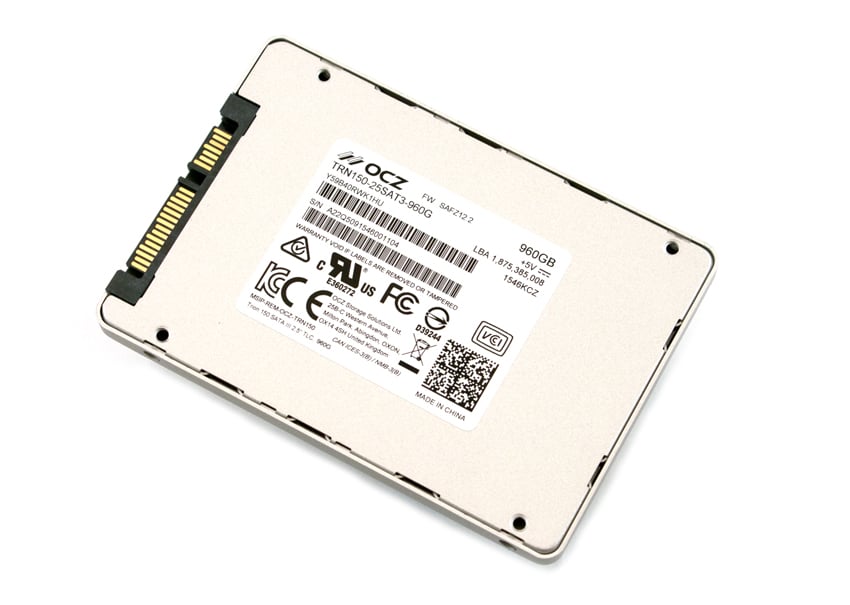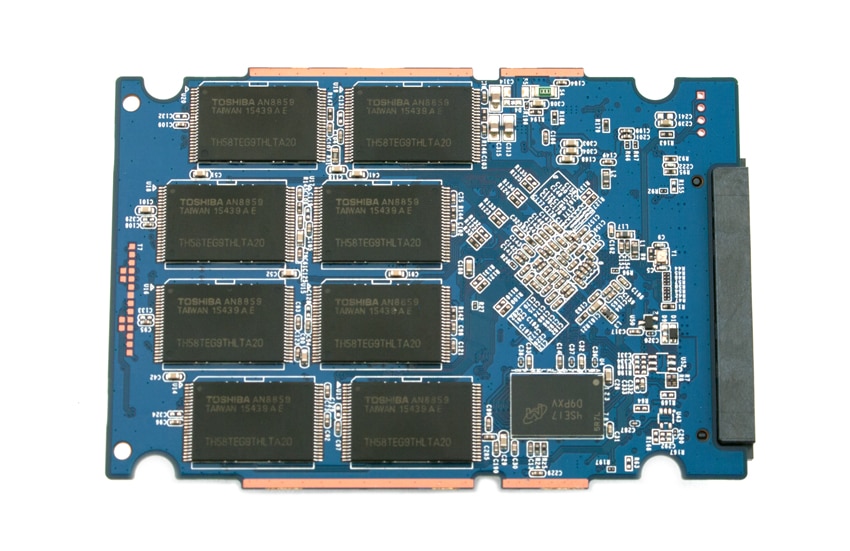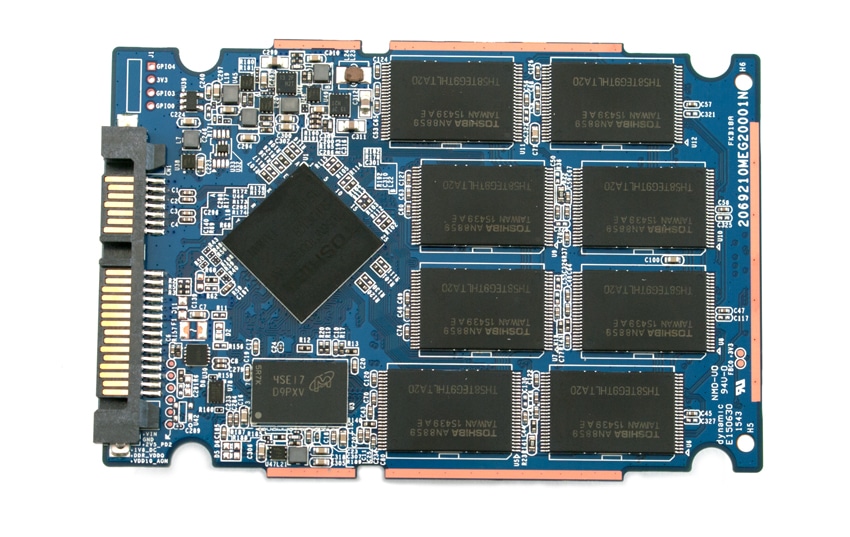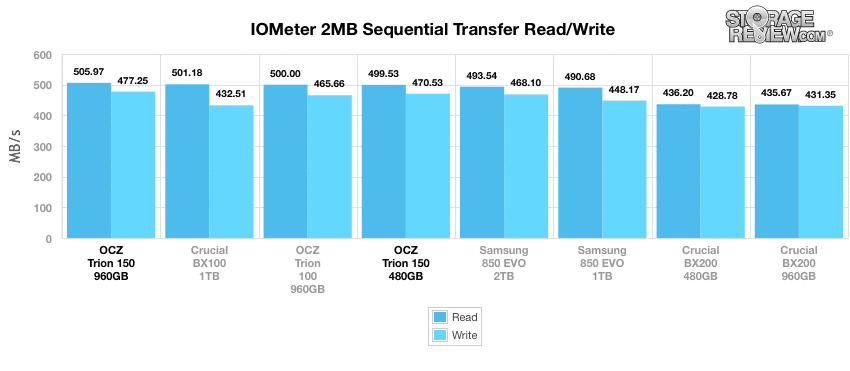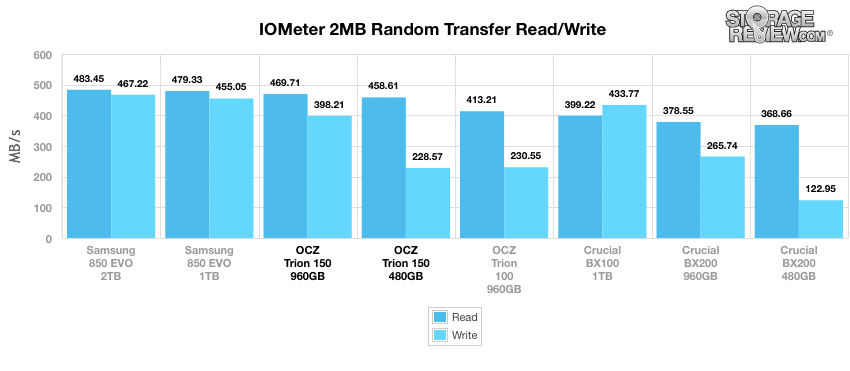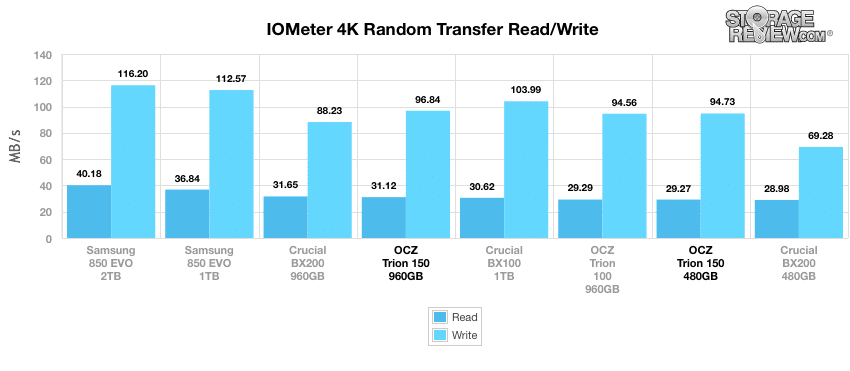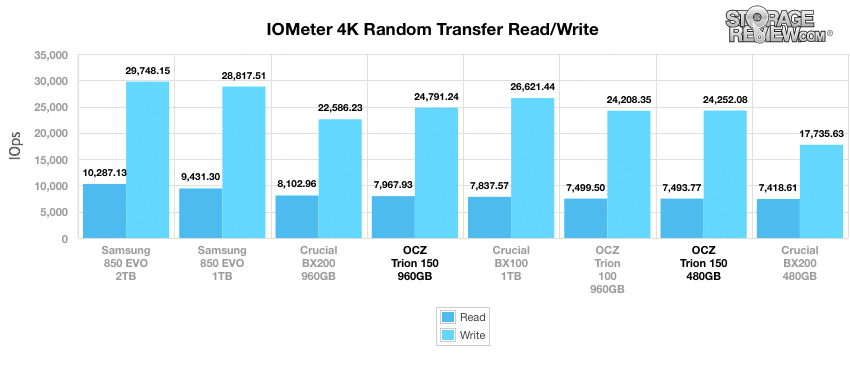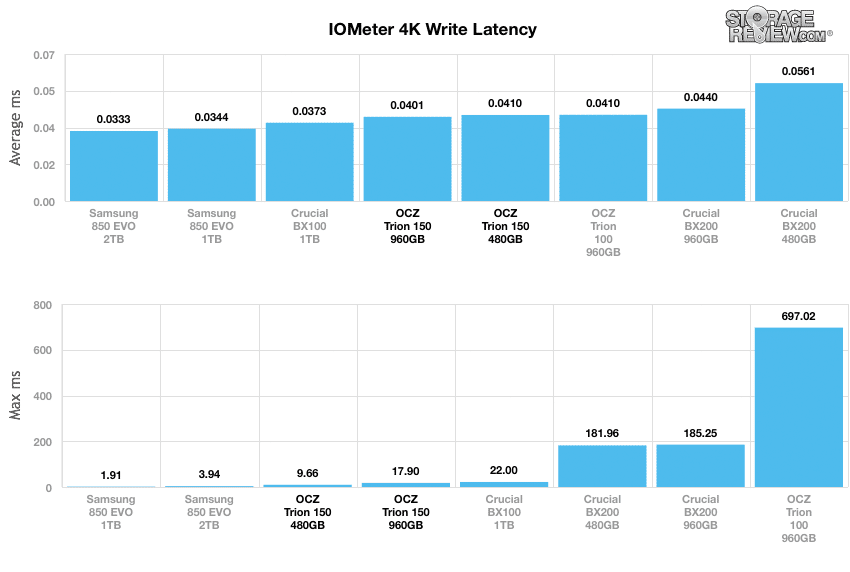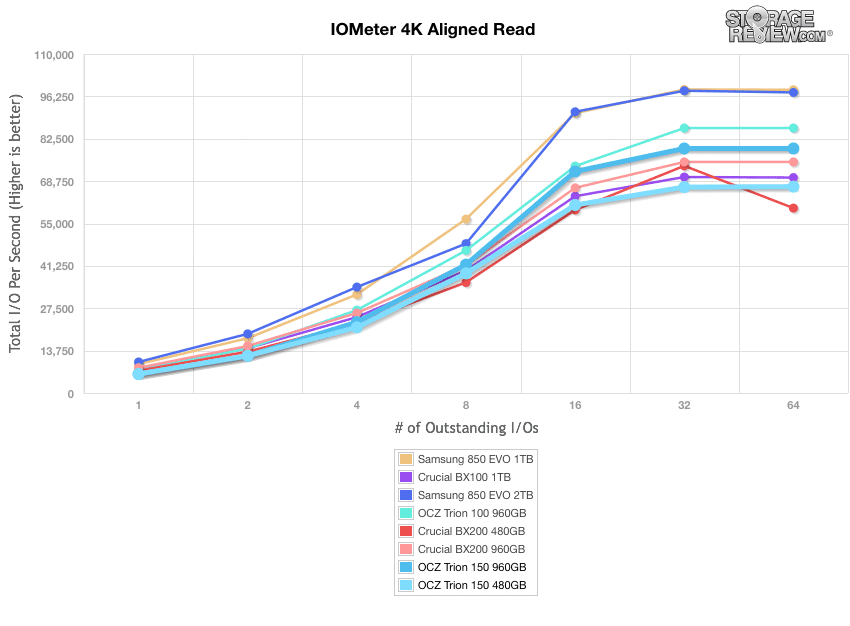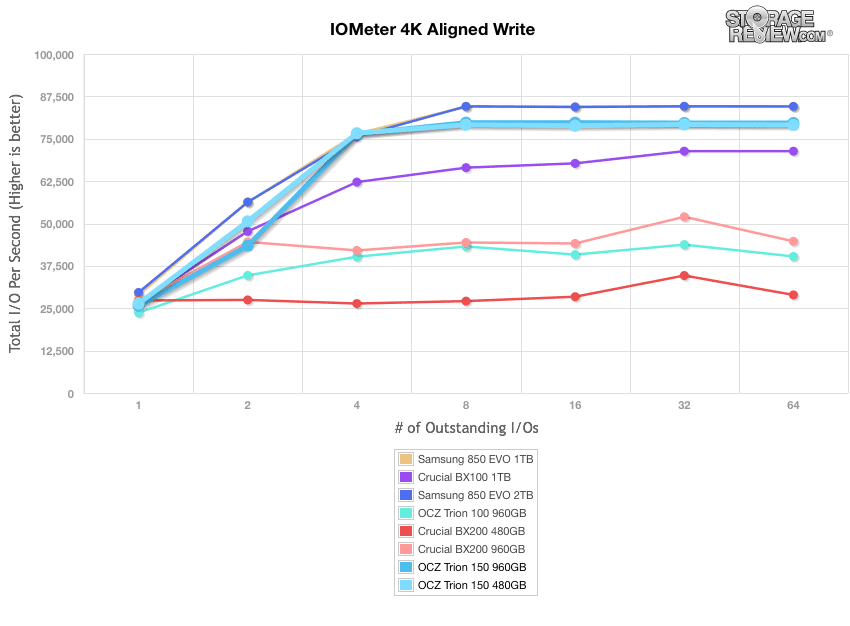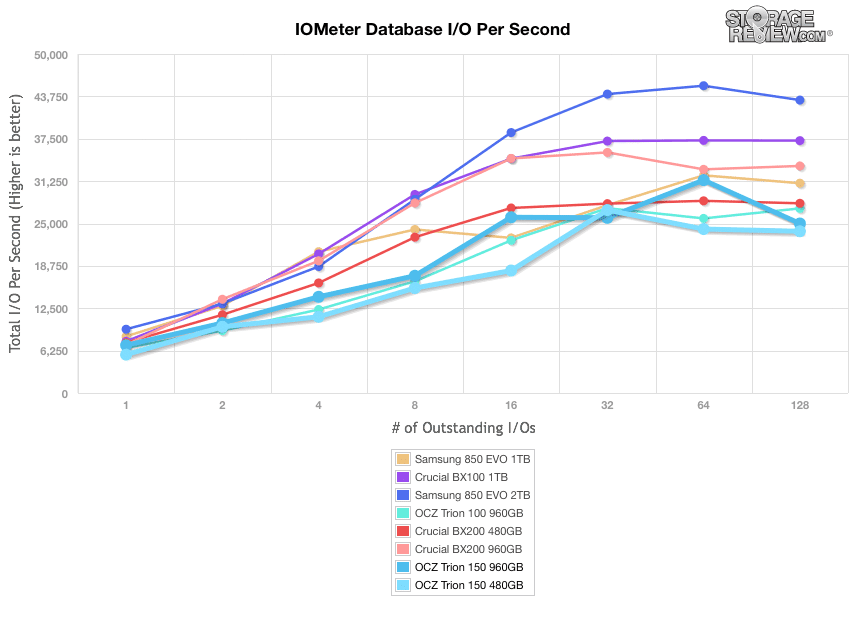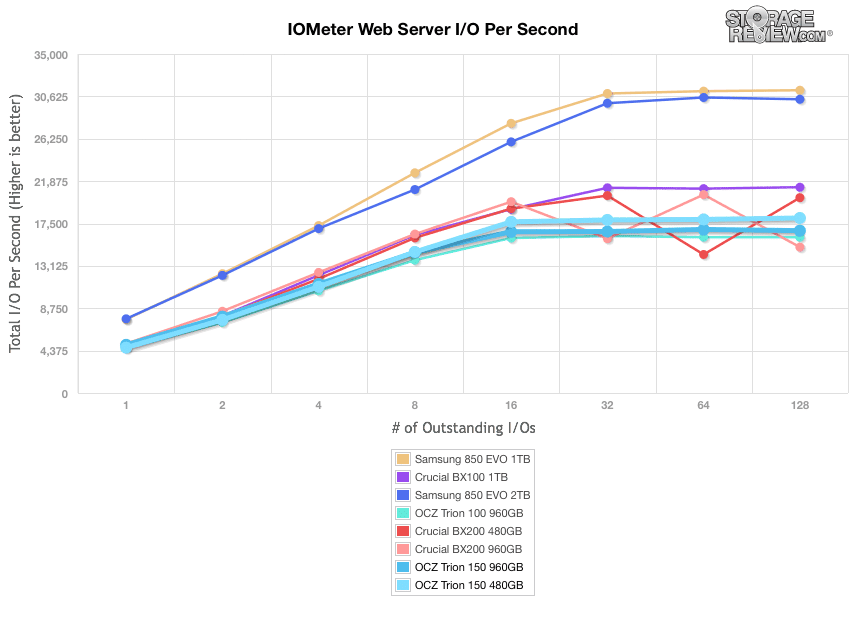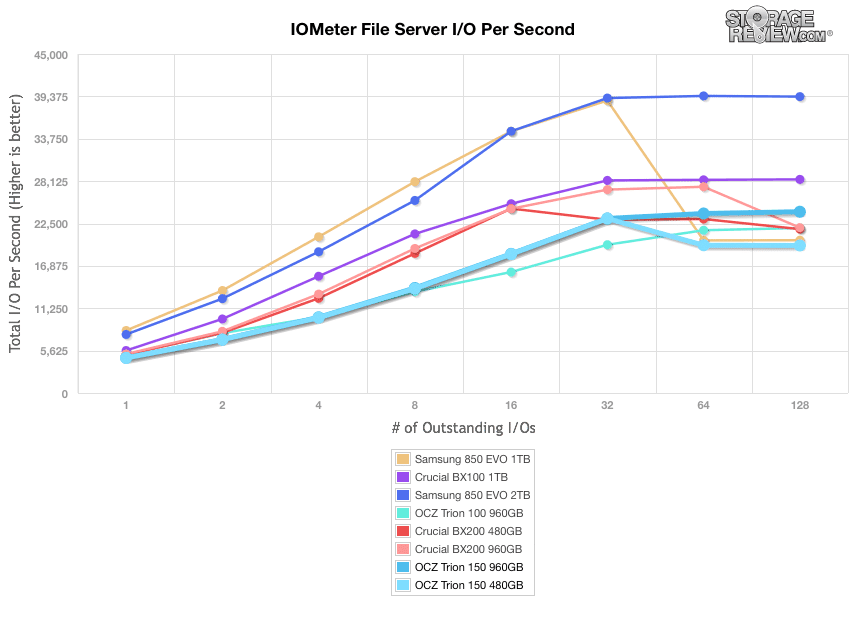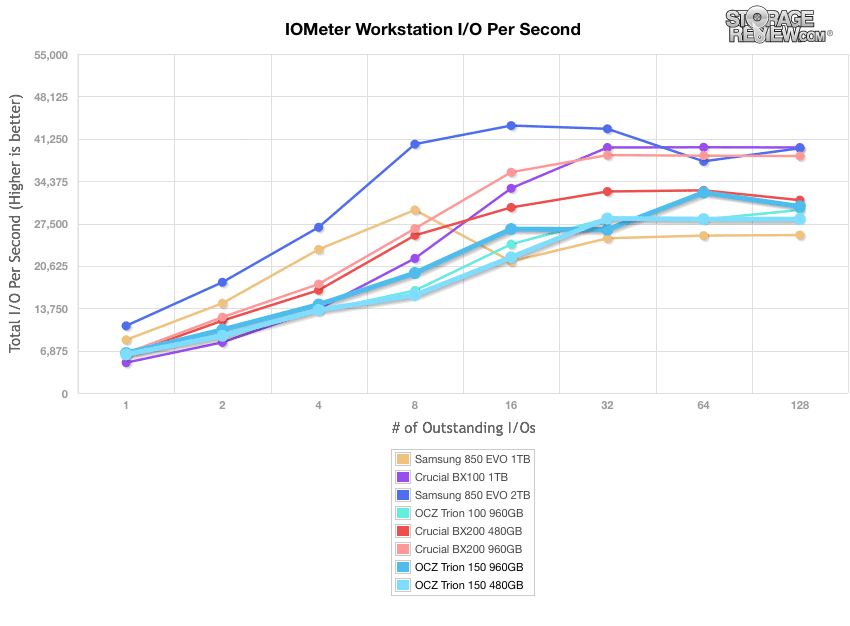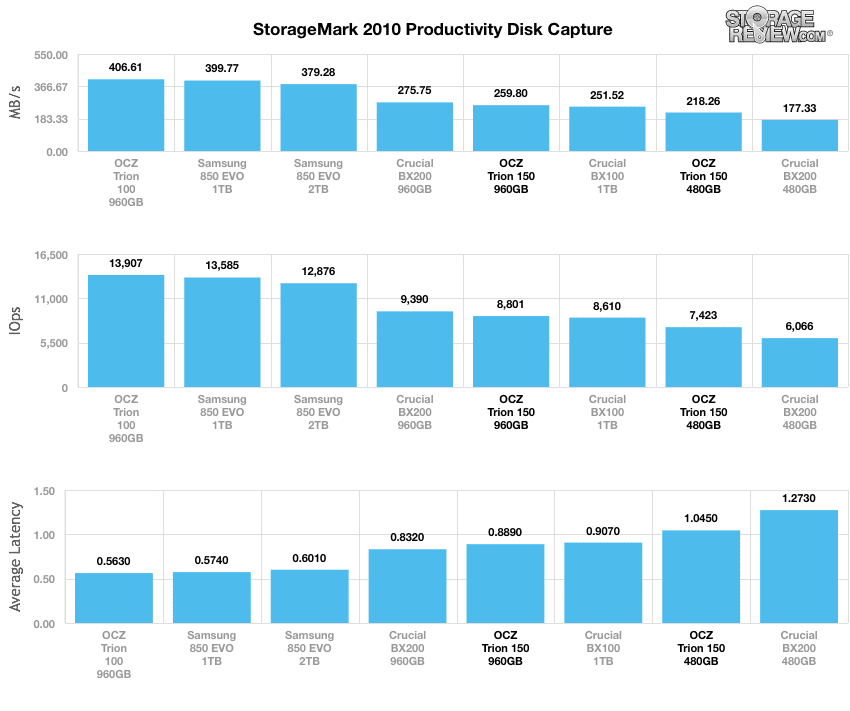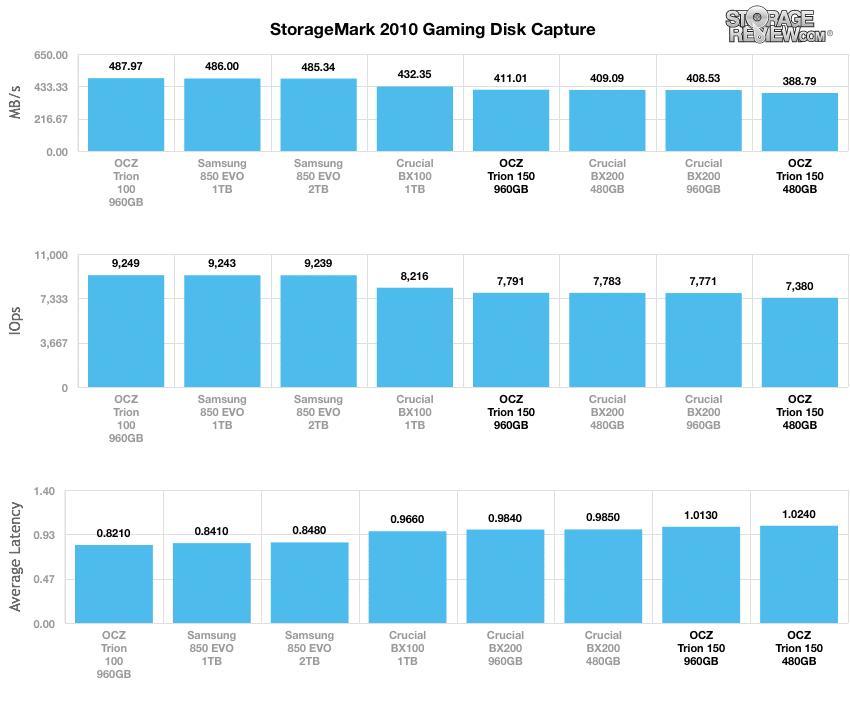
Unveiled during this year’s CES, the new Trion 150 SSD line has finally hit the market. Described by OCZ as the “ultimate HDD replacement” for both mainstream notebooks and desktops, the Trion 150 is specifically designed for first-time SSD buyers who are looking for an affordable way to update their HDD-based system to solid-state technology. The Trion 150 is also the direct successor to the Trion 100, which we found to be a fairly impressive drive for its price point due to its excellent real-world performance.
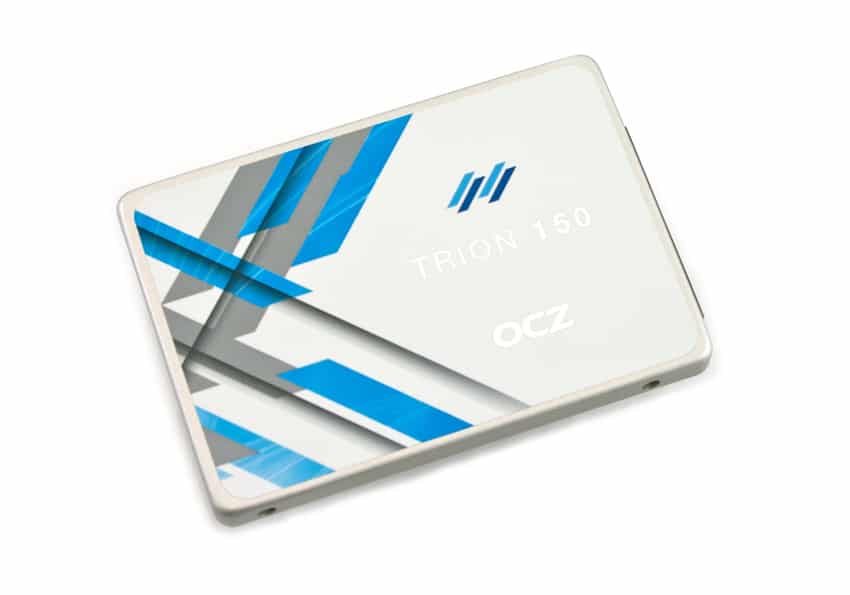
OCZ’s new SSD line leverages Toshiba’s 15nm TLC NAND flash technology (compared to the Trion 100’s a19nm NAND) and is quoted to deliver upwards of 550MB/s in sequential reads speeds and 450MB/s for sequential writes while random write I/O performance is quoted at 91,000 IOPS. Though the specifications are identical to the Trion 100, OCZ claims that users will experience up to a 50% increase in performance in many real world use cases. The new line also has endurance claims of 240TB TBW.
When it comes to warranty plans, OCZ has certainly set the bar high over the past few years with its ShieldPlus program. In essence, this warranty system eliminates the annoyances that are inherent of servicing faulty drives. It does this by removing shipping loops and costs to the consumer; simply provide OCZ support with the SSD’s serial number, and if it is deemed to be effective, you will be sent shipped a brand new drive (no receipt is necessary). This adds even more value to an already inexpensive drive. Overall, the whole package of the Trion 150 is quite attractive
The Trion 150 comes in capacities of 120GB, 240GB, 480GB, and 960GB and is priced at just $50, $70, $140, and $270, respectively.
OCZ Trion 150 Specifications:
- Capacities: 120GB, 240GB, 480GB, 960GB
- NAND: Toshiba 15nm Triple-Level Cell (TLC)
- Interface: Serial ATA (SATA) 6Gb/s (SATA III)
- Form factor: 2.5-inch, 7mm height
- Dimension (L x W x H): 100.00 x 69.85 x 7.00 mm
- Weight: 48g
- Performance
- 120GB | 240GB | 480GB | 960GB
- Max Read: 550 MB/s | 550 MB/s | 550 MB/s | 550 MB/s
- Max Write: 450 MB/s | 520 MB/s | 530 MB/s | 530 MB/s
- Max Random Read (4KB, QD32): 79,000 IOPS | 90,000 IOPS | 90,000 IOPS | 90,000 IOPS
- Max Random Write (4KB, QD32): 25,000 IOPS | 43,000 IOPS | 54,000 IOPS | 64,000 IOPS
- Steady-State Random Write (4KB, QD32); 2,200 IOPS | 3,200 IOPS | 3,200 IOPS | 3,600 IOPS
- Endurance
- TBW: 30TB | 60TB | 120TB | 240TB
- Daily Usage Guidelines: 27GB/day | 55GB/day | 110GB/day | 219GB/day
- MTBF: 1.5 million hours
- Warranty: 3 years, ShieldPlus
Design and build
The Trion 150 uses the same color scheme to other OCZ SSDs, though it has updated overall design. Its enclosure is comprised of an all-alloy build in an ultra slim, 2.5 inch form factor using a white/blue/light blue branding that works rather well. It’s very modern looking, which is something you don’t see very often on hard drives, as most of their life cycle takes place inside a computer.
The back panel has a standard label, which includes the norm: serial numbers, model number,PNs, etc. The sides of the drive have two screw holes each for easy mounting while the front of the SSD has a standard SATA power and data interface.
As we stated above, its small form-factor allows enables the new OCZ drive to be used from almost all applications such as ultrabooks and desktop PCs.
To access the interior of the drive, simply pop the top and bottom pieces of the external case apart. This will reveal the Toshiba controller and Toshiba 15nm TLC NAND.
Consumer Synthetic Benchmarks
All consumer SSD benchmarks are conducted with the StorageReview HP Z620 Workstation. We compared the Tiron 150 with the following comparables:
- Samsung 850 EVO 2TB (SATA, 6Gb/s, Samsung MHX controller)
- Samsung 850 EVO 1TB (SATA, 6Gb/s, Samsung MEX controller)
- Crucial BX100 1TB (SATA, 6Gb/s, PSilicon Motion SM2246EN controller)
- Crucial BX200 480TB (SATA, 6Gb/s, Silicon Motion SM2256 controller)
- Crucial BX200 960TB (SATA, 6Gb/s, Silicon Motion SM2256 controller)
- OCZ Trion 100 960GB (SATA, 6GB/s, Toshiba controller TC58)
All IOMeter figures are represented as binary figures for MB/s speeds.
In our first test, we will measure 2MB sequential performance. The Trion 150 960GB posted a leading 505.97MB/s read and 477.25MB/s write, taking top spot in both categories. The 480GB model wasn’t far behind with 499.53MB/s read and 470.53MB/s write, which placed it in the upper middle part of the pack.
In 2MB random transfer performance, Trion 150 960GB slowed done just a tad, measuring 469.71MB/s read and 398.21MB/s write while the 480GB model recorded 458.61MB/s read and 228.57MB/s write, which placed both capacities at the upper middle part of the pack.
Switching to smaller 4K random transfers, the Trion 150 960GB posted middle of the run results with 31.12MB/s in read activity and 96.84MB/s for writes. The 480GB was right behind the larger capacity model with 29.27MB/s read and 94.73MB/s write. The top performing drive here was the Samsung 850 EVO 2TB with 40.18MB/s read and 116.20MB/s write.
When looking at IOPS, both Trion 150 capacities found themselves with similar numbers once again: the 960GB model posted 7,967.93 IOPS read and 24,791.24 IOPS write and the 480GB posted 7,493.77 IOPS read and 24,252.08 IOPS write. Unsurprisingly, the Samsung 850 EVO 2TB had the top results.
Our 4K write latency benchmark looks at both the average and maximum readings. Here, the OCZ Trion 150 960GB posted an average latency of 0.0401ms with 17.9ms in maximum latency. Again, the 480GB model had slightly higher average latency with 0.041ms; however, it had significantly lower maximum results with 9.66ms.
Our next test shifts to a 4k random workload with 100% read activity that scales from 1QD to 64QD. In this scenario, the Trion 150 960GB scaled from 25711.95 IOPS up to 25,711.95 IOPS, trailing just Samsung EVO drives. The 480GB capacity actually had a better initial speed of 26,339.87 though it fell just behind its larger brother in the terminal with 79,063.73 IOPS.
In write activity, the Trion 150 960GB ranged from 6,148.59 IOPS to 79,348.86 IOPS (placing it near the top of the leaderboard) while the 460GB model measured 8,180.51 IOPS at QD1 and 74,978.97 IOPS at in the terminal queue depths.
Our last series of synthetic benchmarks compare the SSDs in a series of server mixed-workloads with a queue depth of ranging from 1 to 128. Each of our server profile tests has a strong preference towards read activity, ranging from 67% read with our database profile to 100% read in our web server profile.
The first is our database profile, which consists of a 67% read and 33% write workload mix primarily centered on 8K transfer sizes. Here, the Trion 150 960GB had the weakest performance among the tested drives with an IOPS of 24,998.2 and 23,857.77 in the terminal for the 960GB and 480GB, respectively. The Samsung EBO 2TB was the runaway winner here.
When looking at web server profile (read-only with a spread of transfer sizes from 512-byte to 512KB) the Trion 960GB drive posted a range of 4,973.547967 IOPS to 16,762.185602 IOPS while the 480GB model offered 4,684.01 IOPS to 18,066.91 IOPS. Both drives placed at the bottom of the leaderboard.
The next profile looks at a file server, with 80% read and 20% write workload spread out over multiple transfer sizes ranging from 512-byte to 64KB. Here, the 960GB delivered a range of 4,667.27 IOPS and 24,063.35 IOPS, while the 480GB model ranged from 4,654.40 IOPS to 19,586.20 IOPS.
The last profile looks at workstation activity with a 20% write and 80% read mixture using 8K transfers. The Trion 150 960GB posted burst speeds of 6,482.45 IOPS and ended up with 30,262.90 IOPS by Q128, which placed it in the middle of the pack. The 480GB model recorded 28,209.59 IOPS in the terminal.
Consumer Real-World Benchmarks
For the average consumer, trying to translate random 4K write speeds into an everyday situation is pretty difficult. It helps when comparing drives in every setting possible, but it doesn’t exactly work out into faster everyday usage or better game loading times. For this reason we turned to our StorageMark 2010 traces, which include HTPC, Productivity, and Gaming traces to help readers find out how a drive might rank under these conditions.
The first real-life test is our HTPC scenario. In this test we include: playing one 720P HD movie in Media Player Classic, one 480P SD movie playing in VLC, three movies downloading simultaneously through iTunes, and one 1080i HDTV stream being recorded through Windows Media Center over a 15 minute period. Higher IOPS and MB/s rates with lower latency times are preferred. In this trace we recorded 2,986MB being written to the drive and 1,924MB being read.
In our HTPC profile, the Trion 150 480GB and 960GB had virtually the same results. That said, it placed well behind the rest of the pack with an IOPS of 6,637.81 and 6,579.62, respectively and far behind its predecessor, the Trion 100.
Our second real-life test covers disk activity in a productivity scenario. For all intents and purposes this test shows drive performance under normal daily activity for most users. This test includes: a three hour period operating in an office productivity environment with 32-bit Vista running Outlook 2007 connected to an Exchange server, web browsing using Chrome and IE8, editing files within Office 2007, viewing PDFs in Adobe Reader, and an hour of local music playback with two hours of additional online music via Pandora. In this trace we recorded 4,830MB being written to the drive and 2,758MB being read.
In our Productivity trace, the Trion 150 960GB posted 8,801.14 IOPS, 259.8MB/s, and an average latency of 0.889ms, while the 460GB model posted 7,423.29 IOPS, 218.26MB/s, and an average latency of 1.045ms. Though this was an improvement on the performance from the last profile, they were both still significantly behind the Trion 100, which placed at the top of the leaderboard.
Our third real-life test covers disk activity in a gaming environment. Unlike the HTPC or Productivity trace, this one relies heavily on the read performance of a drive. To give a simple breakdown of read/write percentages, the HTPC test is 64% write, 36% read, the Productivity test is 59% write and 41% read, while the gaming trace is 6% write and 94% read. The test consists of a Windows 7 Ultimate 64-bit system pre-configured with Steam, with Grand Theft Auto 4, Left 4 Dead 2, and Mass Effect 2 already downloaded and installed. The trace captures the heavy read activity of each game loading from the start, as well as textures as the game progresses. In this trace we recorded 426MB being written to the drive and 7,235MB being read.
In our read-intensive gaming trace, the Trion 150 960GB posted 7790.94 IOPS, 411.01MB/s, and 1.013ms in average latency of 0.889ms, while the 460GB model posted 7379.58 IOPS, 388.79MB/s and an average latency of 1.024ms.
Conclusion
The Trion 150 is one of the least expensive SSD lines out there, bringing reliable solid-state drive technology to laptops and desktops looking for upgrades. It comes in a 2.5″ (7mm) form factor with the standard SATA 6Gb/s interface, Toshiba NAND, and a Toshiba Controller. Though mainstream consumers will likely see a huge increase in performance compared to their previous hard-disk drive setups, it doesn’t quite measure up to the higher-end consumer drives on the market like the Samsung EVO. That being said, OCZ certainly did not design the Trion 150 to compete with those drives in the performance category but rather focused on an ultra-low price tag and power efficiency; even more so than the Trion 100. Many first-time SSD buyers–which is its target demographic–will undoubtedly appreciate this.
You could almost say that OCZ’s ShieldPlus warranty program is worth the price of an OCZ drive alone. Return policies are often a pain for consumers when a product unexpectedly fails; both the wait time and the endless loops of communication. The ShieldPlus program gives OCZ customers a peace of mind that this will not happen: simply give them the SSD’s serial number and, if deemed faulty, they will immediately send you a brand new drive at no cost. The whole process works very well and it’s really nice to see something like this attached to drives as inexpensive as the Trion 150 line.
When looking at the details of its performance, results were a bit underwhelming. With the exception of the 2MB sequential and random transfer rates (which recorded an impressive 505.97MB/s read and 477.25MB/s write and 469.71MB/s read and 398.21MB/s write, respectively, for the 960GB model), the Trion 150 posted numbers that placed it either in the middle or at the bottom of the leaderboard. Though this was certainly expected, it even struggled to keep up with its predecessor, the Trion 100.
Looking at our smaller 4k random transfers and latency benchmarks showed middle of the pack results. Here, the Trion 150 960GB posted 31.12MB/s in read activity and 96.84MB/s for writes, while the 480GB was close behind with 29.27MB/s read and 94.73MB/s write. Measuring IOPS told a similar story, with the 960GB model posting 7,967.93 IOPS read and 24,791.24 IOPS write and the 480GB recording 7,493.77 IOPS read and 24,252.08 IOPS write. Our server mixed-workloads and consumer real world benchmarks showed the Trion 150 near or at the bottom of the leaderboard.
Ultimately, however, the Trion 150 performed as we expected. Power consumers who already leverage solid-state technology will undoubtedly avoid this drive; however, there are still many people who will find a ton of value and performance with the Trion 150. No matter how you look at its performance results, OCZ’s new drive will act as a significant upgrade to anyone who still uses HDDs as their main drive and at a very low cost. At a price tag at under $50 for their smallest capacity (120GB) and $270 for their highest (960GB), this is a fantastic price-per-GB ratio and even better than its predecessor, the Trion 100 (the 960GB currently goes for around $290 on Amazon and Newegg). You will also likely see the price being driven down even more later this year.
Pros
- Industry leading warranty program
- One of the most inexpensive SSD lines on the market
- Great sequential transfer speeds
Cons
- Overall sub-par performance
- Outperformed by the Trion 100 in many of our tests
Bottom Line
Though the Trion 150 offers supremely adequate though underwhelming performance compared to higher end consumer drives, its inexpensive price tag and fantastic warranty program makes OCZ’s newest economical drive an attractive upgrade option.
Sign up for the StorageReview newsletter

